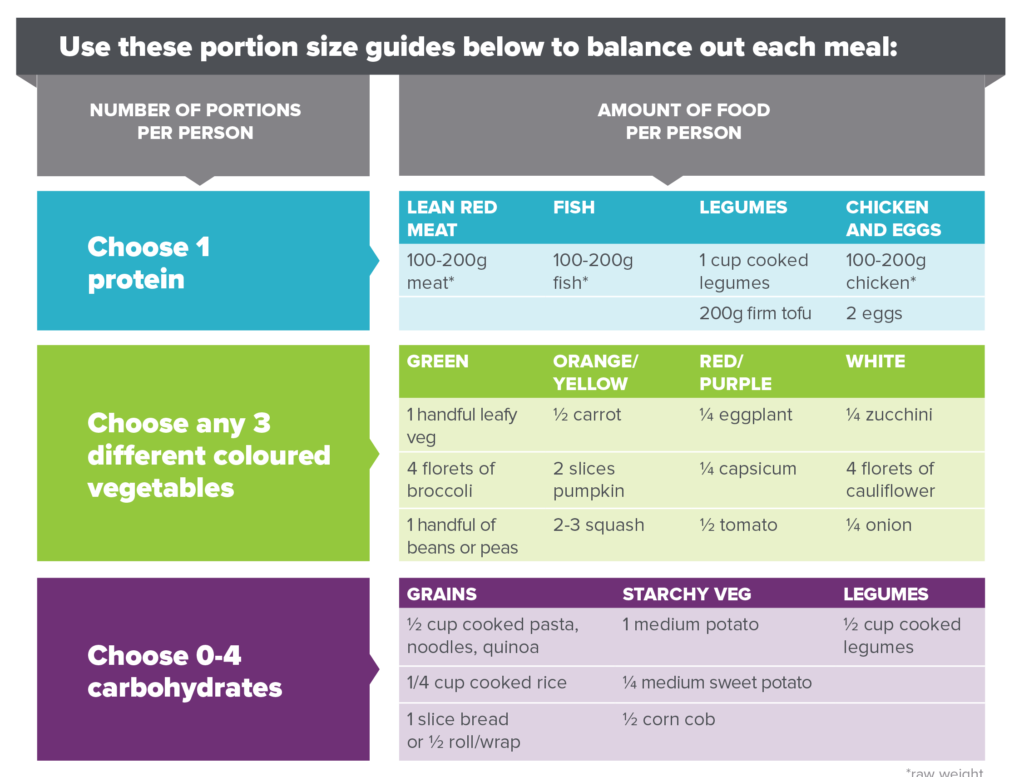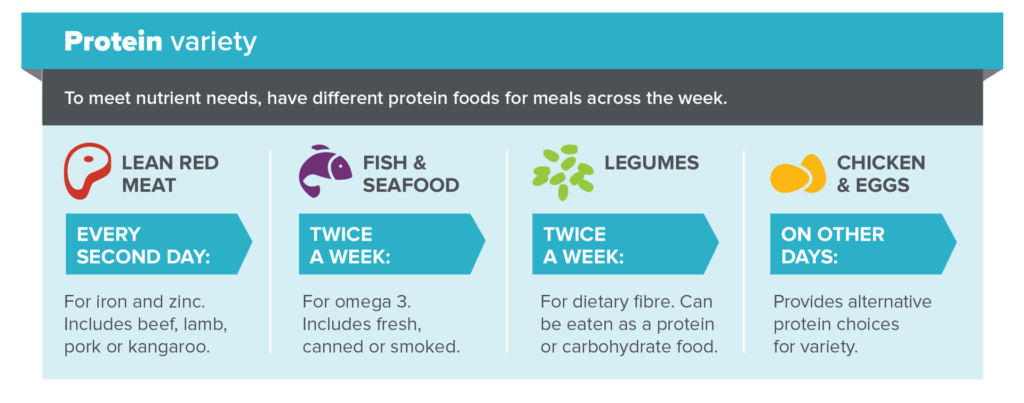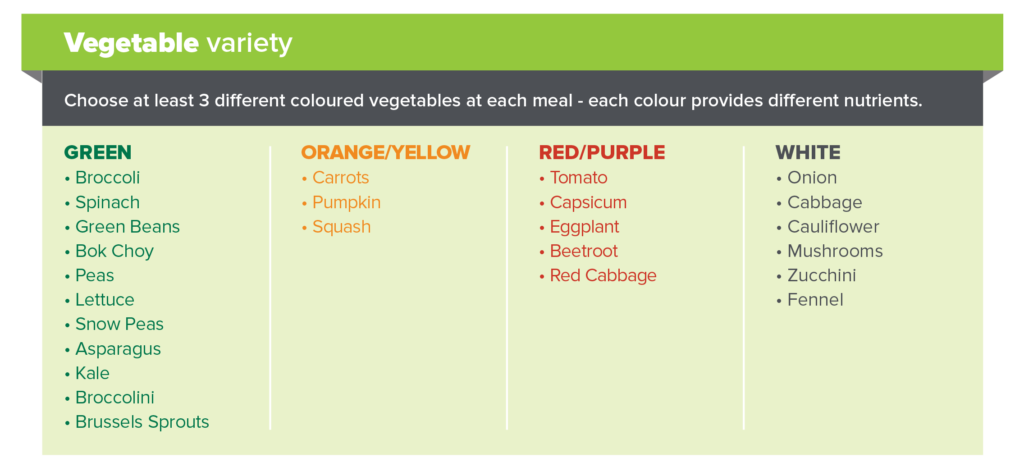Eating food in amounts recommended in the Australian Dietary Guidelines promotes health and avoids food waste, key to sustainable consumption.
THE AMOUNT OF FOOD CONSUMED EXPLAINS UP TO 25% OF THE ENVIRONMENTAL FOOTPRINT OF THE AUSTRALIAN DIET.1
Sustainable diets have a low environmental impact, and are nutritionally adequate, accessible, affordable, and culturally acceptable.2
Whether measuring the impact of climate, water scarcity, cropland scarcity, or pesticide toxicity, Australian research shows that the amount of food consumed is the main determinant of the environmental impact of the diet.1,3-7
The findings suggest that changes in agricultural practices are necessary to achieve sustainable production1,3, while eating to your needs and avoiding food waste is important for sustainable consumption.1,7,8
Dietary factors that determine the amount of food consumed include the number of portions and serving size of food, frequency of consumption, and variety of food choices within each food group.
The Australian Dietary Guidelines9 provides guidance on the amounts and variety of food choices recommended for people of different ages and life stages to achieve a healthy diet and maintain a healthy weight.
Three ways to promote sustainable eating and avoid food waste
- Maintain a healthy weight: eat foods in recommended amounts
- Improve diet quality: eat a variety of nutritious foods to promote health
- Reduce household food waste: buy only what you need
Health care professionals, such as GPs and dietitians, have an important role to play in promoting healthy, sustainable eating for all Australians by providing practical messages to drive behaviour change and positive health outcomes.
How can GPs help their patients?
Patients are looking for easy ways to fit healthy, balanced meals that are affordable and enjoyable into their busy lifestyles.
Decisions about food choices and portions are typically made within the context of meal planning.10 Meal planning guidance builds practical skills that make it easier for your patients to integrate healthy and sustainable eating habits into their everyday meals.
Portion guidance in line with the Australian Dietary Guidelines9 is an effective way to help your patients choose the right food, in the right amounts, to promote health and avoid food waste.
MLA’s Guide to Balanced Meals resource provides practical tips for planning and serving healthy, balanced meals using portion size guides.

Include a variety of protein foods to meet different nutrient needs such as iron, zinc, and omega 3 fatty acids.

Choose a range of different coloured vegetables to provide important nutrients such as vitamin A, C, and antioxidants.

Modify the amount of carbohydrate with the meal depending on individual energy needs and physical activity levels.

Practical resources
Meat & Livestock Australia’s nutrition resources are based on typical meal planning practices and are consumer-tested to ensure the information is engaging, achievable and easy to understand. These patient-friendly resources provide practical tips and portion guidance to help patients eat to their needs and make every bite count. For more information and access to the resources, visit MLA Healthy Meals.
Who is MLA?
Meat & Livestock Australia (MLA) is an industry owned Rural Research and Development Corporation that delivers marketing, research and development services to Australia’s red meat and livestock industry. The Australian red meat and livestock industry is committed to reducing its environmental impact through adoption of new technology and production practices. Read about the industry’s ambitious target to be carbon neutral by 2030 (CN30 roadmap) and its sustainability progress here.
References
- Ridoutt B, Baird D, Hendrie G. (2021) Diets within environmental limits: The climate impact of current and recommended Australian diets. Nutrients 13(4):1122. doi.org/10.3390/nu13041122
- World Health Organization (2019) Sustainable healthy diets: Guiding principles. Food and Agriculture Organisation of the United Nations (fao.org)
- Ridoutt B, Baird D, Hendrie G. (2021) Diets within planetary boundaries: What is the potential of dietary change alone? Sustain Prod Consum. 28:802-10. doi.org/10.1016/j.spc.2021.07.009
- Ridoutt B, Baird D, Anastasiou K, Hendrie G. (2021) An assessment of the water use associated with Australian diets using a planetary boundary framework. Public Health Nutr. 24(6):1570-75. doi.org/10.1017/ S1368980021000483
- Ridoutt B, Anastasiou K, Baird D, Garcia JN, Hendrie G. (2020) Cropland footprints of Australian dietary choices. Nutrients 12(5):1212. doi.org/10.3390/nu12051212
- Ridoutt B, Baird D, Navarro J, Hendrie G (2021). Pesticide toxicity footprints of Australian dietary choices. Nutrients 13(12):4314. doi: 10.3390/nu13124314.
- Hendrie G, Baird D, Ridoutt B, Hadjikakou M, Noakes M. (2016) Overconsumption of energy and excessive discretionary food intake inflates dietary greenhouse gas emissions in Australia. Nutrients 8(11):690. doi. org/10.3390/nu8110690
- Ridoutt B, Hendrie G, Noakes M. (2017) Dietary strategies to reduce environmental impact: A critical review of the evidence base. Adv Nutr. 8(6):933-46. doi.org/10.3945/an.117.016691
- National Health & Medical Research Council (2013) Australian Dietary Guidelines. Canberra (ACT): NHMRC. www.nhmrc.gov.au/adg
- Meat & Livestock Australia (2019). Healthy Meals Report. Sydney (NSW): MLA. Healthy-meals-report.pdf (mlahealthymeals.com.au)





